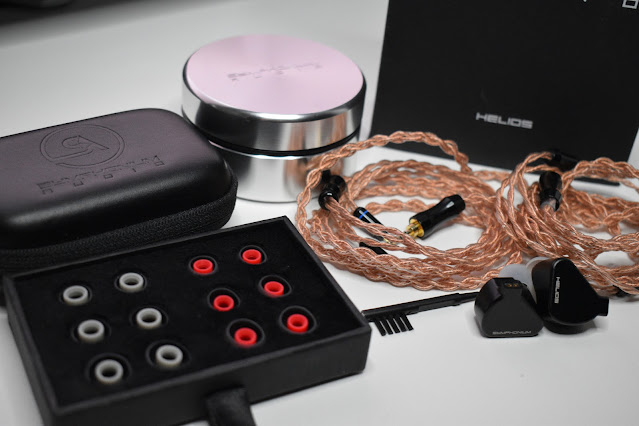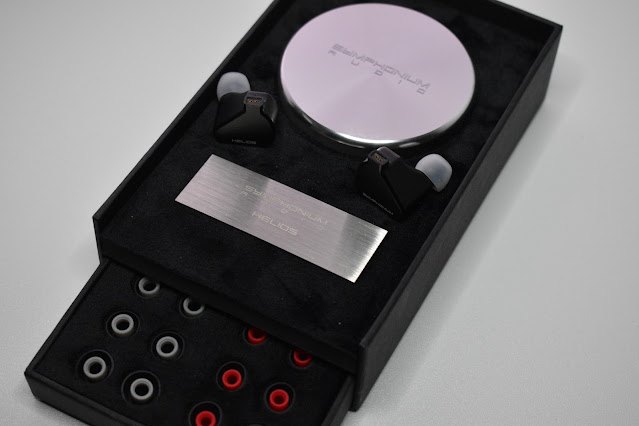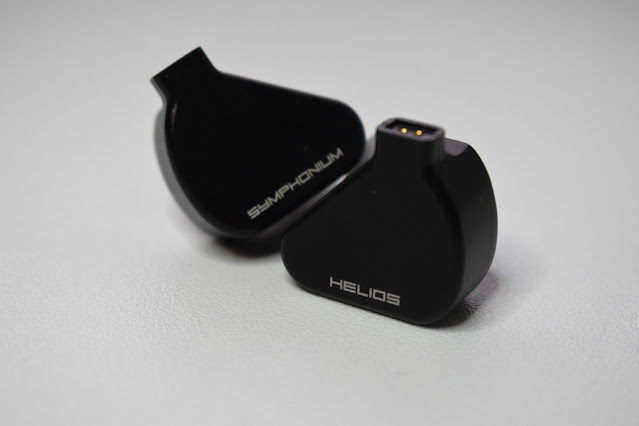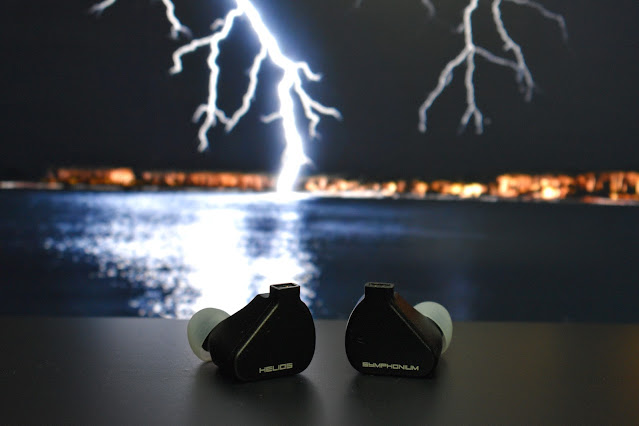The following, as usual, is also available in Spanish on my blog and on YouTube, links at the end of the post.
The Symphonium Helios have been sent to me on loan from the company Symphonium Audio without a request for anything at all. I am very grateful for the loan of these IEMs as I would not have had a chance to try them out and they are certainly a set that have changed my view on IEMs as a whole, but more on that in a moment.
You can find the Helios on the Symphonium site here: Helios – Symphonium Audio
As always, my review and opinions will be as sincere and honest as possible but you do need to factor in two things, first that it hasn’t cost me anything to try out these IEMs and second, I may have already had some preconceived impressions of these IEMs before I even received them.
I will explain more on why I may have some preconceived impressions in a second but as I am someone who believes in honest and unbiased reviews, along with sharing as much information as possible, I have arranged with Symphonium to allow me to send these on to two other Spanish reviewers who know nothing about them. The Helios will be going to both Vertex, who posts his reviews on the YouTube channel “Auricular ORG” (in Spanish), and to Cqtek, who posts his reviews in English and Spanish on hiendportable.com, so please check out their reviews as well (I have no idea what they will think of them but I do know that they will share their unbiased opinions!).
Anyway, with that cleared up, let’s get on with the Helios!
Intro…
The Helios is a very recent release from a company called Symphonium Audio that has very few models and I only know about them due to the Helios and the talk of these IEMs in a Discord server that I am part of, along with people who worked on the design of the Helios and some reviewers whose opinions I have a lot of trust in.
This is the reason for the possible preconceived impressions that I mentioned, as I have heard nothing but praise for these IEMs since they started getting heard by those reviewers and by some other non-reviewers who have also had the chance to try them. It was actually quite an experience to see people try them and as soon as they passed them along, place their order for them. This obviously made me expect something great from the Helios, as there is no better positive publicity than people hearing them and then spending 1000€ to own them.
And that is another part of my impressions, I have never experienced a 1000€ set of IEMs before. In fact, it wasn’t too long ago that I said that 100€ was my limit for a set of IEMs and although I have broken that limit a couple of times, I am still a long way from having spent such an amount on a set of IEMs. The main reason is that I always prefer headphones, however, I have started to realize that I do use IEMs more than headphones, mainly due to the heat here for the majority of the year, so I have been more open to higher priced IEMs lately (although I still haven’t made the commitment).
All this is basically nothing to do with the Helios but I thought I would include this information as it gives you an understanding of where I am coming from with my impressions of the Helios, which I can already say is the best set of IEMs I have ever heard.
Presentation…
I am not 100% sure if what I have received is actually the same as what is received in a retail set of these IEMs, as I said, these are a demo unit, but I think that things like cables can be chosen when purchasing from Symphonium.
This set arrived in a black box, which I understand is the retail box, along with another case containing a second cable, wrapped separately.
The extra case is a very nice travel case which is (imitation) leather on the outside, sporting the Symphonium logo, with a nice furry interior. As I said, I am not sure that this case is included with the retail version but I have seen that it is available on the Symphonium webstore for $10 and it really is nice to have the lined interior. Inside this travel case they included a 2.5mm balanced cable.
Inside the main box we get a rather special aluminum storage case, which is round and has a screw off lid. I say this is a storage case as I don’t think I would personally use it for transporting the IEMs due to the size and weight of it, but again, it is very nice and does make it seem like you are receiving something special. The round case is located at the top of the box and has a metal plaque underneath that reads Symphonium Audio Helios. This presentation is rather simple but elegant, again, making it seem like something special.
Inside the storage case are the IEMs, a 4.4mm balanced cable, a small cleaning brush and tool, along with a few Symphonium Audio stickers.
The bottom end of the box has a small drawer that slides out to reveal another metal plaque with the serial number engraved, under which we find 6 extra sets of silicone tips, 3 sizes of large bore and 3 sizes of small bore. As this is a demo unit and I already have hundreds of tips in different sizes and styles, I haven’t actually used the included tips.
As far as the presentation, that about sums it up. Again, it is rather simple but elegant and includes enough accessories, although an unbalanced cable would have been nice but that will depend on the source that each person is planning on using.
Build and aesthetics…
Starting off with the IEMs themselves, they are very simple rounded triangles, all black, with Helios on one side and Symphonium on the other. To be honest, they are nothing much to look at, they are a simple shape and finish that does not jump out as being anything special, they certainly aren’t something that screams “expensive” to someone who doesn’t know IEMs, which can be a good thing depending on your use case.
They are also quite large and have a fair weight to them, with quite a long nozzle that is also on the larger side (although not to the extent of some nozzled like those of the iSine or Blessing). I found that a lot of tips didn’t slide all the way to the end of the nozzle, making the Helios stick out from my ears a little too much, although they still weren’t uncomfortable in this way. However, they are meant to be used with a deep insertion, meaning that I needed to select tips that are a little longer and also of a smaller size (as the seal happens further inside my ear). To be honest, I am not a great fan of deep insertion but they still weren’t too uncomfortable even when pushed deep.
The rest of the contents are of good quality, the accessories are great, as I mentioned, and the cables are nice. I guess my only complaint, which is not really a complaint, is that the cables do not have preformed memory wire or ear hooks, but that is not my complaint (I actually praise them not being preformed), it is the fact that the 2 pin sockets on the IEMs do not have a guide for the connectors and as the cables are not preformed, it makes connecting them out of phase very easy. This is easily overcome by looking at the channels on the connectors themselves, making sure they are the correct way round, but I can see people making mistakes and ending up with left and right out of phase by accident.
Sound…
So, I already said these are the best IEMs I have heard. That is obviously enough to know that my impressions of sound are very positive, but that still doesn’t mean that they are perfect for everyone, or that they are even perfect for me.
I am going to go through my usual steps as far as sound but I want to point out beforehand that any negatives are minor and they are relative to what I want from a 1000€ IEM, not because the IEMs have any faults themselves.
As I have said with reviews of headphones, once we reach a certain sound quality, the rest is more about preference. That doesn’t mean that all headphones or IEMs above a certain price point are great, there are some that don’t hit the “certain quality” mark, but that is definitely not the case with the Helios, they surpass the that “certain quality” with ease, so it puts them in a zone where personal preference becomes the main deciding factor.
Starting off with the subbass, it is excellent.
Ok, I guess I better be a little more specific  The extension of the subbass is great, reaching far lower than my hearing range, providing plenty of rumble but keeping it very clean and articulate, never seeming to lose control over even the lowest frequencies.
The extension of the subbass is great, reaching far lower than my hearing range, providing plenty of rumble but keeping it very clean and articulate, never seeming to lose control over even the lowest frequencies.
Now, I already knew what the measurements of these IEMs looked like way before I got them, and also heard praise for the subbass, but even so, I was very surprised. As I have mentioned many times, I am not a bass head and the graph of the subbass would place these well over my preferences, but the sound doesn’t. The cleanliness and presentation of the subbass means that the power to rumble is there, but it doesn’t just add it to everything, it just presents what the track needs at each time.
I don’t think I have mentioned yet that the Helios is a 4x BA set up, which is something that doesn’t really attract me on paper. I am a lover of dynamic driver bass, probably due to the fact that I have spent all my life listening to bass from dynamic drivers so it is what I find natural. In the case of headphones, I said that the HE1000se (and now possibly the Arya Stealth Magnet version) were the first headphones to make me feel that I didn’t need a dynamic driver for bass tonality and it seems that the Helios can take that same claim for subbass in IEMs. The rumble, articulation, coherency are all just mixed together perfectly for my tastes in subbass.
I can’t finish the subbass section without mentioning “Chameleon”, which is usually a good stress test for an IEM subbass, however, in this case, it is more of a massage for the eardrum, giving a sensation of power that I have not experienced in an IEM before without it becoming overpowering and uncontrolled.
Moving up to the mid bass ranges, the articulation and speed are again there, making any tracks, no matter how busy in the bass areas, sound clean and never seeming to lack any dynamics in the bass area. However, and this is my first negative (which I repeat, is relevant to what I am looking for, not because it is bad), I feel that the midbass is lacking a little bit of warmth and presence to be totally natural on the majority of music that I listen to.
I listen to a lot of acoustic guitars and basses in my music preferences, some samples of which can be found on my test list, such as “Tears in Heaven” by Eric Clapton, “Free Fallin’” by John Mayer or “Seven Nation Army” by Zella Day, just to name a few. With this kind of music I find that the acoustic guitar (and upright bass in something like “Back it Up” by Caro Emerald), lacks a little bit of body to meet my preferences for these instruments.
I know by looking at the graph that the mid bass is slightly below my preferences as far as presence but even with a little bit of EQ in this area, I still don’t find it to be as natural as I would like, which I think could be due to these frequencies being handled by a BA and not a DD. Again, I must stress that this is some very minor nitpicking on my behalf, it is not that the instruments sound totally off, far from it, they just don’t seem to have the body that I love about the midbass of an acoustic guitar or bass.
When listening to similar styles of music that uses electric guitars rather than acoustic, such as “Give Me One Reason” by Tracy Chapman or “Sugar” by Francesco Yates, I do not get this same feeling. I feel that is more relative to the fact that I have been listening to acoustic guitars in a live setting (unamplified) since, well, forever, and it makes it difficult for them to sound the same.
With tracks that move more towards rock, such as “Whole Lotta Love” by Led Zeppelin, then I find the midbass to be great, with great clarity and coherency that makes it possible to even appreciate effects used in dirty tones such as “Bombtrack” by Rage Against The Machine.
Moving out of the bass and into the mids, there is no need to mention the transition as there is absolutely no hint of anything that resembles bleed or bloat. This is obviously helped by that small lack of presence in midbass (in comparison to other sets) but also the fact that these IEMs are so clean and fast that it is not even something to consider.
The mids themselves are very well presented, keeping up with that clarity and speed found throughout the whole of the frequency ranges. Voices are clear and upfront but without becoming harsh or pushing their way too far forwards. From vocals such as Dominque Fils-Aimé on “Strange Fruit”, through to Beth on “Don’t You Worry Child” (who can easily become harsh), I have no complaints about them at all. There is great balance between the male and female vocals on tracks such as “Billie Jean” by the Civil Wars, without either overshadowing the other.
Songs with multiple voices, such as “Hallelujah” by Pentaonix or “These Bones” by The Fairfield Four, are separated perfectly and allow all the layers to be easily identified. I also need to point out that the very deep voice on “These Bones”, which could possibly be affected by the midbass that I mentioned earlier, does not seem to be lacking in warmth at all, which goes to prove even more my point about it being relative to my expectancy of the acoustic guitar rather than the IEMs.
Moving up into the higher regions, I must say that this is by far the best treble I have heard on a set of IEMs. Everything is smooth, articulate, airy, all those words that actually mean nothing but serve to try and explain the sound. There is no issue with sibilance, although it doesn’t tame it either, so if the track is recorded with sibilance, the Helios is not going to hide it. I can see that maybe the treble would be slightly too much (but only slightly) for some people but personally I really can’t pick faults with the treble of the Helios, it is great and, again, by far the best I have heard in an IEM.
The soundstage is also way above the average I have come to expect from IEMs. I mean, it is not an Arya v2 (nothing is really an Arya v2) but it does place itself in the category of being open and spacious, something that is not common on IEMs that I have tried.
Something that helps add to the spaciousness is the detail and placement of images inside the soundstage. This means that it makes the most of the space that is available, placing images in a way that makes it easy to appreciate small changes in placement and making the whole picture seem larger than it actually is. This is by far the most detailed IEM that I have heard also.
Conclusion…
I think that I have made it clear that I am very impressed with the sound of the Symphonium Helios, as I have already said a couple of times, it is easily the best sounding IEM I have heard. The details, spaciousness, sound signature, there really isn’t anything that can be called an issue, it is just an amazing set of IEMs.
Now, I guess that thousand euro question is… would I actually spend a thousand euros on the Helios?
Let me say that I am very tempted and just the fact that I am even contemplating spending this kind of money on a set of IEMs is proof that I am really impressed with them.
So, what is stopping me?
Well, apart from the fact that I still feel that 1k is a lot of money for a set of IEMs (it was only a year ago that I thought it was crazy), if I was to spend it, I would want something that is perfect. By this I don’t mean a perfect set of IEMs, I mean something that is perfect for me, and there are really only two things that I don’t find perfect about the Helios for my personal taste.
The first is comfort. While these are not uncomfortable IEMs, they are also not the most comfortable IEMs I have worn. I always notice them in my ears. As I said, I am not a fan of deep insertion and these do go a little deeper than my preference. I can also get a good seal by using tips that sit further away from the shell and they still sound great, but not quite as amazing as when inserted properly. I also find that the back part of the triangle shape rests on my ear and the top sticks out at an angle, causing the cable to be at a weird angle also, which is not terribly uncomfortable but it is something that I notice constantly.
The second thing that has me hesitating is the mid bass / lower mids timbre that I mentioned. With almost all music except for that based on acoustic guitars and basses, this is not even an issue, however, a very large part of my listening is based on music that revolves around these two instruments. Again, this is not bad by any means, far from it, but it is just not the perfection that I would hope to achieve by spending this much on a set of IEMs.
Now, both of those reasons are completely personal. Comfort is a very personal thing and my impression of an acoustic guitar’s natural timbre may not coincide with yours. You may not even listen to any music that involves acoustic instruments at all, in which case I would not be able to point out a fault at all as far as sound. I have listened to all kinds of music throughout the week and there really isn’t any genre that I haven’t enjoyed on the Helios. Even music that is based on acoustic guitars has been thoroughly enjoyable, I really am nitpicking when I talk about that “body” of the instrument.
You might even be someone with plenty of disposable income and think that 1000€ is a very reasonable price, which I guess it is in comparison to other IEMs that are twice as expensive, or even 3, 4 or 5 times more expensive. I obviously haven’t heard any of those more expensive models but based on commentary from people that I trust, I don’t think the Helios has anything to worry about as far as sound quality in comparison.
So, I am still on the fence about the purchase but what I am not on the fence about is the fact that they are an amazing set of IEMs that I am very grateful to Symphonium for sending out to me, giving me the opportunity to get to hear them.
As I mentioned at the beginning, I am sending these on to Vertex and Cqtek for them to share their unbiased opinions of these IEMs as, again, I might have already had a preconceived opinion before starting this review, so I would suggest checking out their reviews once they have had chance to publish them (heck, they might not even like the Helios!). I will update this review with a link to their reviews once they are available.





